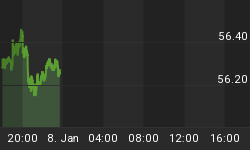Marc Faber of the Gloom Boom Doom Report was interviewed by Bloomberg on Friday, and of course topic number one was the brutal takedown of gold. Not all that surprisingly, he likes the resulting buying opportunity and expects "a major low in gold within the next two weeks."
More interesting from a theoretical/historical point of view was his segue from gold to the state of the global economy:
"Today we have commodities breaking down including gold and we have bonds rallying very strongly. If you just stand aside and just look at these two events they would suggest that there are strongly deflationary pressures in the system."
The following chart illustrates Faber's point. Gold is the downward-trending blue line and long-term Treasury bonds are the upward-trending green line; bonds up, gold down is clearly a deflationary picture:
Gold versus T-Bonds
But how, with the US, Europe and Japan running massive fiscal deficits and buying up every piece of debt in sight, could the global financial system be contracting instead of ratcheting towards an inflationary crack-up boom?
Because even with all the new currency creation, the amount of bad debt that was incurred over the past 30 years is still immense. The eurozone, despite the kind of debt monetization in which the European Central Bank (the Bundesbank's successor!) was never supposed to engage, is falling apart. Any of five or six zone countries could implode on any given day, potentially unraveling the whole system. European businesses and consumers are understandably reluctant to borrow and spend. And since Europe is a major market for everyone, a slowdown there equals a slowdown everywhere. (Even mighty Singapore, offshore money haven to the world, is contracting.) The US, last year's debt monetization champ, is flirting with austerity via sequesters and "grand deficit bargain" negotiations. Unfunded liabilities continue to soar across the developed world. Toss in a quadrillion dollars notional value of derivatives that no one understands or can even locate, and the debit side of the ledger still dwarfs the various QE programs.
In other words, today's level of debt monetization is apparently not big enough, and now the system is rolling over. The Long Wave is winning after all.
[A little background: This series is based on the observation that all the major Long Wave economic theories (loosely defined to include Kondratieff, Elliott, and Fourth Turning), which view multi-decade emotional/psychological/cultural cycles as the driving force in national economies, have concluded that the expansion that began during WW II has ended, and that we should now be deep in a 1930's style, capital "D" depression. Below is an idealized picture of the Kondratieff wave, which puts the onset of "winter" in 2000. That we're not in a depression today is due to the fact that the world's governments are, for the first time in history, armed with unlimited fiat currency printing presses and are using them to dump huge amounts of liquidity into the banking system. This is buying time, at the cost of ever-increasing debt.]

![]() Larger Image
Larger Image
Chart courtesy of http://longwavegroup.com/
The one data point that doesn't fit with a replay of the 2008 debt panic is the stock market which (along with an incipient US housing recovery) is the main inflationary indicator still standing. Stocks don't normally like deflation. As Faber puts it, "I wouldn't buy stocks because the stock market would be hit by disappointing profits."
S&P 500
So is it 2008 all over again? A sharp break in stocks coinciding with multiple fiscal crises (Slovenia and Portugal look primed, Italy and Japan could go anytime) would revive talk of a deflationary crash. Bad for precious metals in the short run (2008 was maybe the worst-ever year for mining stocks) but great long-term because the inevitable response of governments around the world will be to emulate Japan: decree 2% inflation and create as much new currency as it takes to get there. If the Fed's $3 trillion balance sheet didn't do it, then we'll try $10 trillion. If buying mortgage backed bonds doesn't revive those animal spirits, then junk bonds and stocks are next.
If the Long Wave is indeed winning, we're about to discover the true meaning of an "unlimited" printing press.
















